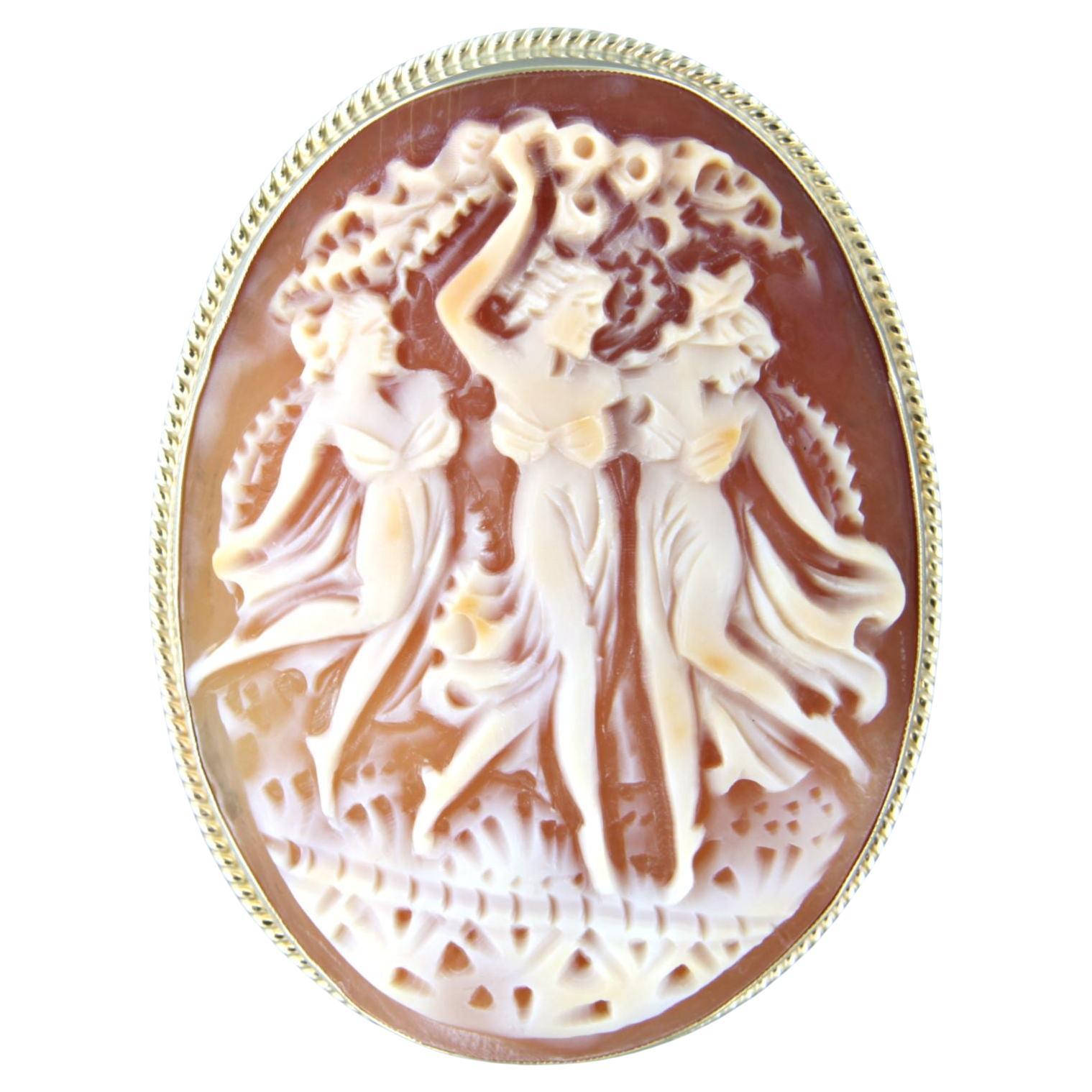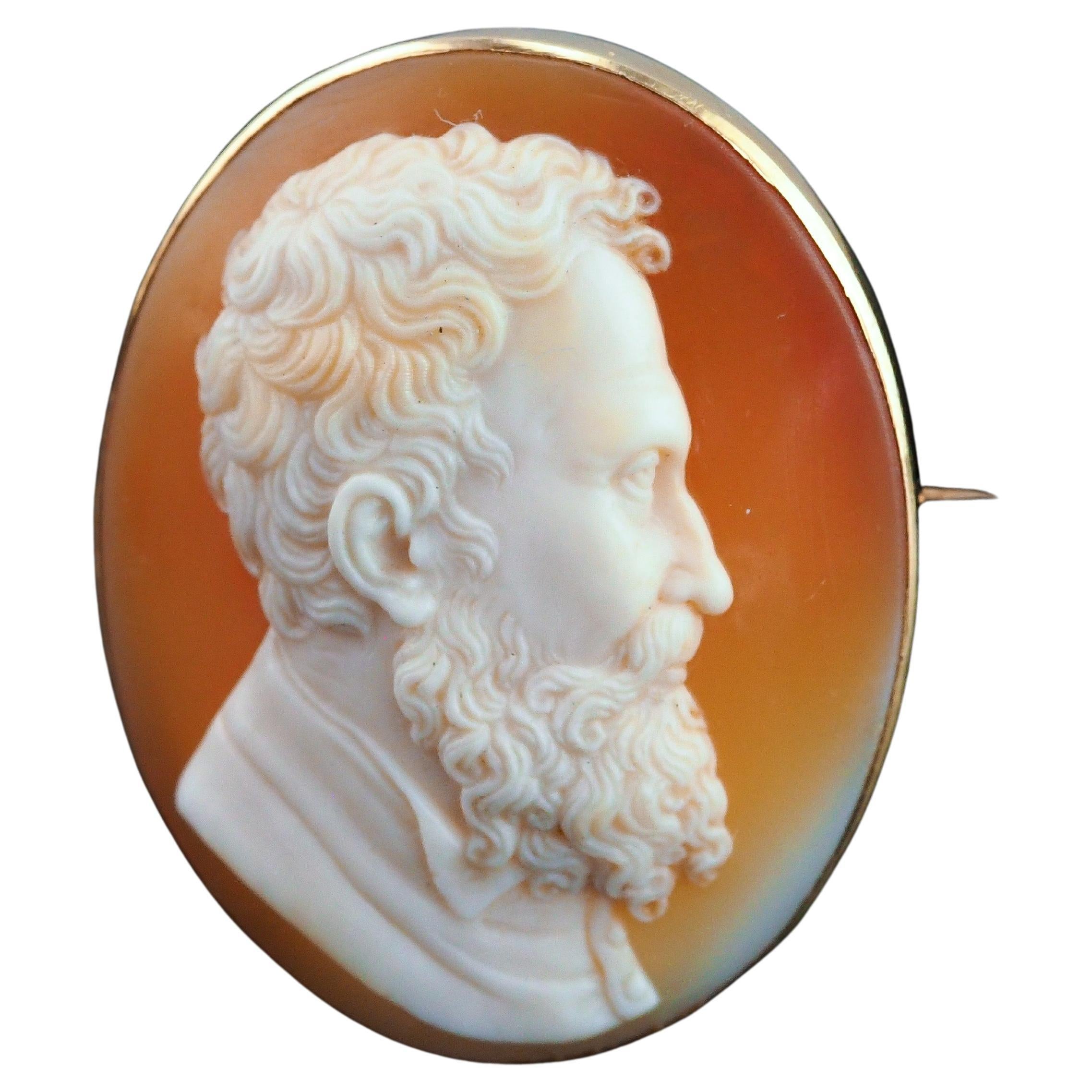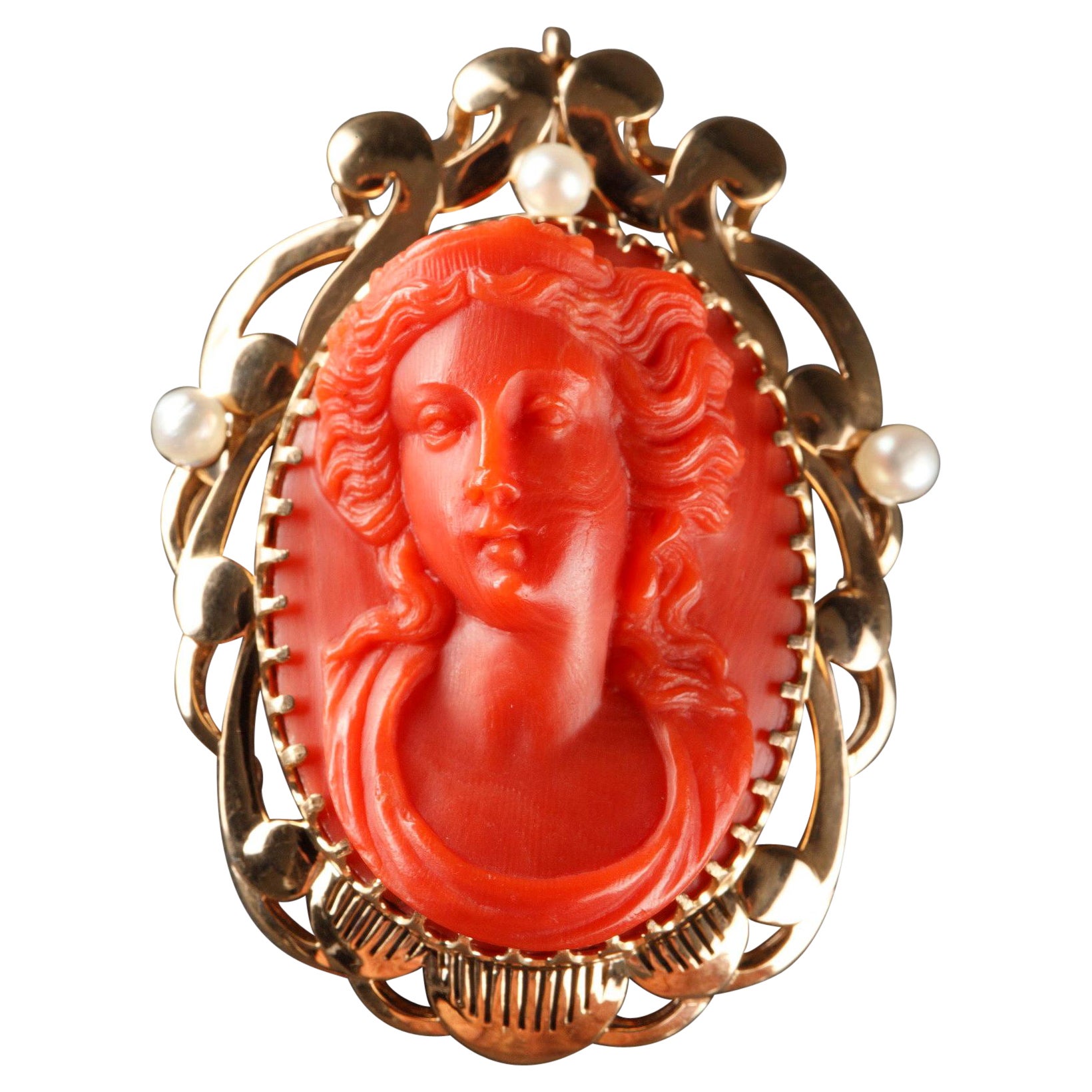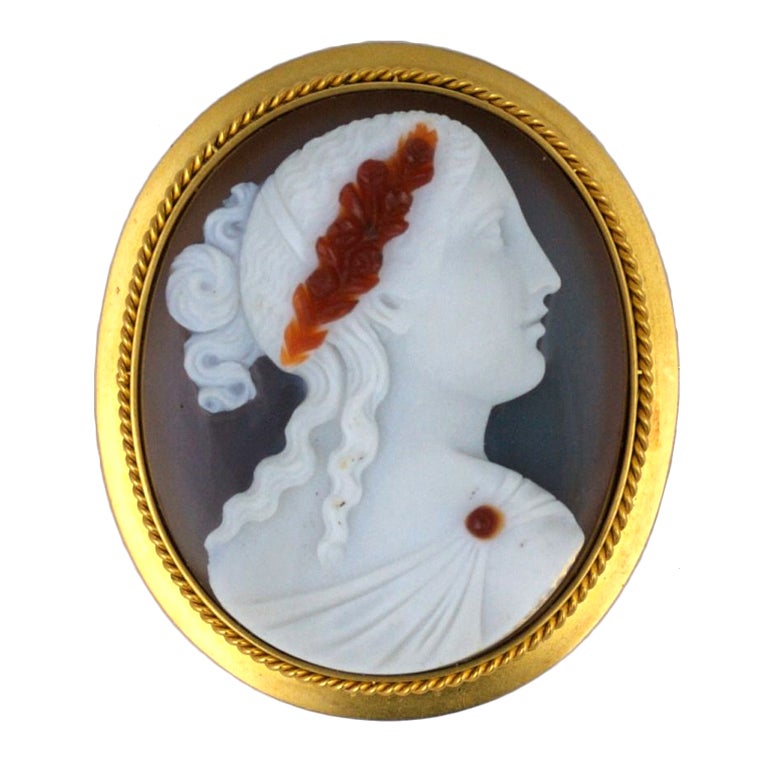Items Similar to Renaissance Portrait Cameo of Emperor Vespasian in a Gold Brooch
Want more images or videos?
Request additional images or videos from the seller
1 of 6
Renaissance Portrait Cameo of Emperor Vespasian in a Gold Brooch
About the Item
Portrait Cameo of Emperor Vespasian in a Gold Brooch
Agate, gold
Italy?, 16th century
Weight 10.2 gr.; Dimensions 48.7 × 39 mm.
Description:
Three-layered agate cameo (black-white-brown) with a laureate head of a Roman Emperor facing left. His white, cleanshaven head with wavy hair is set against a translucent black background and the laurel wreath cut in the brown layer is tied at the nape of his neck with a white ribbon. The reverse side is convex. The collet-set cameo is inserted into a gold brooch with stylized foliage and frames of ornamental corded wires decorating the edges. The brooch is in excellent, wearable condition.
Literature:
The features of the Roman Emperor on the cameo suggest that it is Vespasian (9-79 CE). Coins minted during his lifetime depict him with a long and hooked nose, large and deep eye sockets, and a protruding chin. See, for example, a gold coin in the British Museum, London from 79 CE (inv. no. 1844,0425.1033). Marble busts of the period in the Louvre Museum, Paris (L1261) and Museo Archeologico Nazionale, Naples (inv. no. 6266) confirm the identification. During the Renaissance, portraits of Roman Emperors were fashionable. See an oval pendant with a painted medallion of Vespasian in the same pose in the Musée National de la Renaissance, Ecouen (ECL 22633). Cameos experienced a great revival during the nineteenth century. The brooch mount is in the Archeological Style of the 1860s to 1880s.
During the sixteenth and seventeenth centuries, Northern Italy was renowned for its gem cutters where this cameo was probably carved. For cameos from this period showing Vespasian, see examples in the Royal Collection, London (Piacenti-Aschengreen/Boardman, Modern and Ancient Gems and Jewels in the Collection of Her Majesty the Queen, 2008, no. 89); British Museum, London (Dalton, Catalogue of the Engraved Gems of the Post-Classical Periods, 1915, no. 332); and Staatliche Münzsammlung, Munich (Weber, Kostbare Steine: Die Gemmensammlung des Kurfürsten Johann Wilhelm von der Pfalz, 1992, no. 143). See also exh. cat. Splendeurs des Collections de Catherine II de Russie, 2000, no. 44/25.
- Metal:Gold
- Stone:Agate
- Stone Cut:Uncut
- Weight:10.2 g
- Dimensions:Height: 1.92 in (48.7 mm)Width: 1.54 in (39 mm)
- Place of Origin:Italy
- Period:16th Century
- Date of Manufacture:16th century
- Condition:Wear consistent with age and use.
- Seller Location:Chicago, IL
- Reference Number:
About the Seller
5.0
Vetted Seller
These experienced sellers undergo a comprehensive evaluation by our team of in-house experts.
Established in 1991
1stDibs seller since 2021
5 sales on 1stDibs
Typical response time: 16 hours
- ShippingRetrieving quote...Ships From: Chicago, IL
- Return PolicyA return for this item may be initiated within 3 days of delivery.
More From This SellerView All
- Antique Renaissance Marriage Portrait Cameo in Gold SettingLocated in Chicago, ILRENAISSANCE MARRIAGE PORTRAIT CAMEO IN MODERN GOLD SETTING Italy (?), 16th-17th century White agate, modern gold setting Weight: 10.8 g.; circumference: 54.4 mm.; size: US 7, UK N ½ Substantial rounded D-section hoop, narrowing at the base supports an oblong collet set with a white agate cameo. The cameo features a female bust behind a male bust in profile facing to the viewer’s left. The man has a curly beard, wears a fillet in his closely cropped hair, and wears a draped toga; the woman is less well defined and wears a palla. Both portraits have flat features. The carving has a metallic quality to its lines which enhances the sheen of the stone. The cameo is in excellent condition; the mount is modern. The Renaissance welcomed a revival in the ancient art of gem carving and cameos achieved renewed popularity. Important patrons, like the Medici, employed artists and goldsmiths to make dozens of beautiful examples that harkened back to antiquity and displayed current fashions. Double portraits of a man and woman, as with this ring, are called marriage portraits. They take their form from cameos of Roman rulers, mythological lovers, and citizen couples. Literature This couple could be a sixteenth-century copy of an ancient gem or it could represent a Renaissnce couple in the guise of a Roman couple. The features do not point to any well-known couples. A double portrait cameo in the Royal Collection (RCIN 65861) provides a nice comparison to this ring and is from the same period. For an ancient example of the double portrait cameo see the Metropolitan Museum’s Germanicus and Agrippina (39.22.18) cameo. Another comparison, see the Bibliothèque Nationale, Paris (a 17th-century cameo with the double portrait of a couple in a three-layered agate, published in Babelon, 1897, n. 1019). For general information on Renaissance cameos...Category
Antique 16th Century Renaissance Wedding Rings
MaterialsAgate, Gold, Yellow Gold
- Renaissance Cameo Ring of Galba in a Modern Gold SettingLocated in Chicago, ILRenaissance Cameo Of Galba (?) in Modern Gold Setting Europe, 17th (?) century Onyx and gold Weight: 10.2 g.; circumference: 51.8 mm.; size: US 6, UK...Category
Antique 17th Century European Renaissance Cocktail Rings
MaterialsOnyx, Gold
- Renaissance Rose Gold Sardonyx Cameo RingLocated in Chicago, ILRing with Renaissance cameo Probably Northern Italy, cameo late 16th-early 17th century; ring: second half 18th century Gold, sardonyx cameo (layered...Category
Antique 16th Century Italian Renaissance Fashion Rings
MaterialsAgate, Rose Gold
- Antique Gold and Agate Renaissance Cameo RingLocated in Chicago, ILRENAISSANCE CAMEO RING Italy, cameo: second half of 16th century in a late 18th century ring Gold, agate , black enamel Weight 6.3 gr.; bezel 18.8 x 16.9 x 6.5 mm.; circumference 58.4 mm.; US size 8¾; UK size R Cameo of a nude female bust...Category
Antique Late 17th Century Italian Renaissance More Rings
MaterialsAgate, Gold
- Antique Gold Italian Renaissance Cameo RingLocated in Chicago, ILRENSAISSANCE CAMEO RING Italy? 16th century in a 20th century setting Gold and sardonyx Weight 6.5 gr.; bezel 16.1 x 16.9 x 7.4 mm.; circumference 50.3 mm.; US size 5½; UK size L In this oblong cameo, the bust of a woman wearing a necklace but otherwise nude stands above a blue ground. While her breast faces forward, her head is rendered in a strict profile and her hands gesture to her right. The minimalist gold setting is modern and dates to the twentieth century. Cameos depicting nude female figures became popular in the court circles of sixteenth-century Italy, where newly-formed princely collections of ancient gems served as models for contemporary hardstone artists. Following ancient practice, the artist responsible for the current cameo has cut into two layers of the multicolor agate, creating a background of milky blue that contrasts with the white flesh of the woman above. The sharp profile of the woman’s face likewise recalls the art of the ancient Romans, who often used the profile view for portraits on coins, medals, and engraved gems...Category
Antique 16th Century Renaissance Fashion Rings
MaterialsGold
- Antique Italian Cameo Hair Pin with Double Portrait of Cosimo I de MediciLocated in Chicago, ILCameo with Double Portrait of Cosimo I de Medici and Camella Martelli Cameo, Northern Italy, late 16th century; mount with pin 18th century and later Gold, onyx Weight 3.7 gr.; 14.88 mm. Two-layered onyx cameo (white on translucent pale brown) with jugate heads facing to the right looking upwards. The male head with short curly hair, beard and moustache wears a tunic draped around his neck and shoulders. The female head in the background has her hair tied back. They are cut in the white layer of the stone with translucent pale brown background. The cameo is convex on the reverse and open-set in a pendant with plain gold collet and rounded edges. A long gold pin is attached to the pendant loop and the opposite end has a section of coiled wire Literature: Portraits of Roman Emperors were popular and highly fashionable during the Renaissance period, rulers would often be portrayed like their ancient counterparts, also as a double portrait with spouse, or known as jugate heads. The individual features of the couple portrayed here suggest it could be a double portrait of Cosimo I de Medici (1519-1574) at a slightly older age and his second wife Camilla Martelli, Duchess Consort of Florence (1545-1590) whom he married in 1570. Bust sculptures of Cosimo de Medici in the Galleria Uffizi by Baccio Bandinelli...Category
Antique 16th Century Italian Renaissance More Jewelry
MaterialsOnyx, Gold
You May Also Like
- Antique 18K gold agate female portrait cameo broochLocated in Versailles, FRCameos are works of miniature sculptural art. Their original purpose is lost in history but of the countless ancient examples of the sculptor’s and carver’s craft, none offers such a...Category
Antique 19th Century French Victorian Brooches
MaterialsAgate, 18k Gold
- Antique Victorian Cameo Brooch 14K Gold with Portrait of a Gentleman - c.1890Located in London, GBWe are delighted to offer this superb antique Victorian 14ct gold shell cameo brooch made c.1890. The cameo depicts a bearded gentleman 'in profile' (side on) in exceptional detail...Category
Antique Late 19th Century Brooches
Materials14k Gold
- Cameo Brooch 9k goldLocated in The Hague, ZH9k yellow gold cameo brooch – size 5.3 cm x 4.0 cm Detailed description the size of the brooch is 5.3 cm by 4.0 cm wide weight 15.2 grams set with - 1 x 4.8 cm x 3.7 cm oval cut...Category
Antique 1880s Dutch Early Victorian Brooches
Materials9k Gold
- Gold Cameo Brooch PendantLocated in Paris, FR19th century oval brooch-pendant decorated with a cameo depicting a young woman in Renaissance taste. Gold openwork mounts, heightened with pearls. 1...Category
Antique 1860s French Napoleon III Pendant Necklaces
MaterialsCoral, Gold
- Victorian Hardstone Cameo Gold BroochLocated in Riverdale, NYVictorian high relief sardonyx cameo of maiden with hair wreath decoration. The wreath and dress closure are carnelian toned against her alabaster profile....Category
Antique Late 19th Century Italian Victorian Brooches
MaterialsAgate, 18k Gold
- Shell Cameo in 14 K Gold Brooch/PendantLocated in Bad Kissingen, DE14 k yellow gold shell cameo 19. century Germany 13 gram size 50 x 42 mmCategory
Antique 1880s English Brooches
Materials14k Gold
Recently Viewed
View AllMore Ways To Browse
Cat Brooches
Antique Jewels London
Gold Cat Brooch
Black And White Cameo
Gold Coin Medallion
Gold Coin Mounting
Coin Mount Gold
Roman Brooch
16th Century Style Portrait
Wreath Brooch
Wreath Brooches
Marble Head Portrait
Roman Agate
Antique Cat Jewelry
Roman Coin Pendant
British Coins
16th Century Unknown Portrait
Gold Roman Coin Pendant





